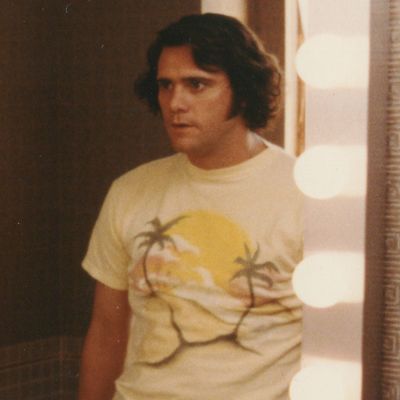
The Jim is Jim Carrey, the Andy is Andy Kaufman, and the & signals the year (1999) when Carrey starred as Kaufman in the biopic Man on the Moon. The hook for Chris Smith’s amazing documentary with the unwieldy title, Jim & Andy: The Great Beyond — Featuring a Very Special, Contractually Obligated Mention of Tony Clifton, is the discovery of behind-the-scenes footage Carrey commissioned of the movie’s shooting. Ultimately, the studio wouldn’t let him do anything with it, for fear, he says in a contemporary interview, that he would “look like an asshole.” Carrey says that with a sad, ironic little smile. Well, duh. He also says he wishes “the behind-the-scenes stuff was part of the movie.” Him and me both.
Actually, Jim & Andy vindicates my negative review of Man on the Moon in Slate: “The reason to see Man on the Moon is Jim Carrey. It’s not just that he does the Kaufman routines with the kind of hungry gleam that makes you think he’s ‘channeling’ the dead comedian. It’s that he knows what it’s like to walk the high wire and bomb. He knows what it’s like to lose control of his aggression: It happened to him in The Cable Guy (1996), maybe his real Andy Kaufman film. I bet that what Carrey saw from inside Kaufman’s head would be more illuminating than anything in the movie. He’s not just a man in the moon: He generates his own light.”
Jim & Andy brings you into Carrey’s head in a way that Man on the Moon didn’t — because the biopic director, Milos Forman (cinema’s most lauded one-trick pony), pressed Kaufman’s story into his standard template of a reckless individualist crushed by society. We know Carrey has the world’s most rubbery face, but what the doc suggests is that in some cases he has (with apologies to the Beatles) a rubber soul. His entry into the Kaufman zone — a willed possession — shows a freewheeling aggression that feeds on itself and touches all aspect of the production, from bullying Forman to — as Kaufman’s sometime alter-ego, Tony Clifton — charging around the Warner’s lot bullying everyone else. The movie is actually painful in how it shows Carrey losing his emotional compass.
Smith weaves footage of Kaufman’s emergence onto the comedy scene with Carrey’s, and suggests that both performers drew from a similar (if not the exact same) well of pain. Although Harry Shearer described Kaufman offstage as both impossible and genuinely insane, Carrey might have felt compelled to go even further. The wrestler Jerry Lawler — with whom Kaufman had raging, spitting, pummeling encounters in and out of the ring — has revealed that the whole thing was completely an act and that in private Kaufman was disciplined and friendly. Carrey, in his re-creations, is bent on truly pissing Lawler off.
Carrey, bearded, seems a long way from both his old self and his old career. His tone in analyzing his and Kaufman’s behavior is extravagantly reasonable, as if trying to prove he’s in a different place. He seems sad. He says when he met with Michel Gondry about starring in Eternal Sunshine of the Spotless Mind that Gondry sensed his inner pain and begged him not to “get well” before the shooting a year down the road. “That’s how fucked-up this business is,” he says. Asked by Smith if he would be in the same place in his life if he hadn’t played Andy, he says, “No.” The part, he suggests, both liberated him and sent him into an emotional tailspin. You come away from Jim & Andy wondering — not for the first time — about the cost to great artists of what they do, envious of their talent and thinking, “I’m glad that’s not me.”


